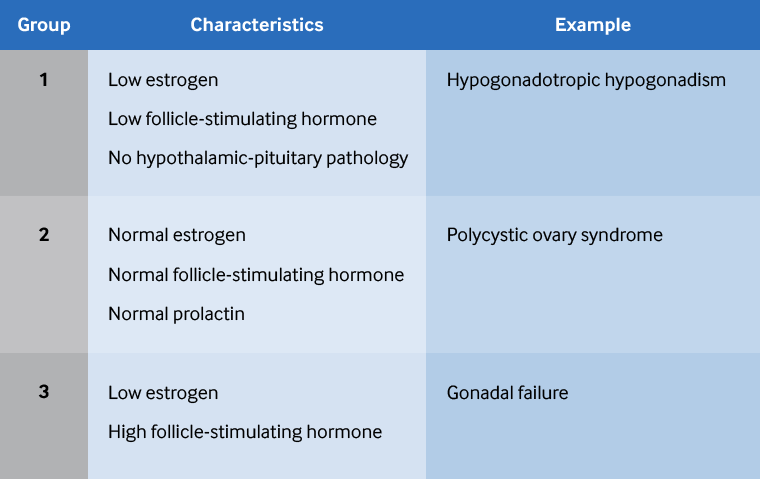Etiology
Amenorrhea may result from pathology in any of the four distinct functional and structural components required for menstruation: the hypothalamus, the anterior pituitary, the ovaries, and the genital outflow tract. Within these components, six conditions account for most patients presenting with primary amenorrhea: polycystic ovary syndrome (PCOS), hyperprolactinemia, thyroid dysfunction, hypogonadotropic and hypergonadotropic hypogonadism, and anatomic abnormalities.[1] In general, primary amenorrhea accounts for a small percentage of pediatric or adolescent patient visits, even at highly specialized centers.
Researchers have found rare variants in genes associated with idiopathic hypogonadotropic hypogonadism in women with hypothalamic amenorrhea, suggesting that these mutations may contribute to susceptibility.[10] Ovarian failure causing primary amenorrhea can also be the result of damage from previous chemotherapy, radiation therapy, or surgery.[1][7]
Some clinicians prefer to approach the patient with amenorrhea based on the presence or absence of a uterus and breast development (signaling estrogen production).[1] A classification system presented by the World Health Organization (WHO) in the 1970s divided patients into groups based on endogenous estrogen production, follicle-stimulating hormone (FSH) levels, prolactin levels, and hypothalamic-pituitary dysfunction.[11] This classification eliminates several diagnoses based on initial information. However, since this system was developed there have been many advances in the understanding of hormonal control of ovulation and improvements in assay methodology, and further workup is required to narrow down the diagnosis.
[Figure caption and citation for the preceding image starts]: World Health Organization classification of amenorrheaCreated by BMJ Knowledge Centre [Citation ends].
In 2021, the International Federation of Gynecology and Obstetrics (FIGO) introduced a three-layered system to categorize ovulatory disorders. The first tier, called HyPO-P (hypothalamus-pituitary-ovary), focuses on anatomy, categorizing disorders into four component groups: type 1: hypothalamic; type 2: pituitary; type 3: ovarian; and type IV: PCOS. The second tier provides more specific causes within the categories: Genetic, Autoimmune, Iatrogenic, Neoplasm; Functional, Infectious and Inflammatory, Trauma and Vascular; Physiological, Idiopathic, Endocrine (GAIN-FIT-PIE). The third tier includes specific diagnoses or disorders.[12]
Use of this content is subject to our disclaimer